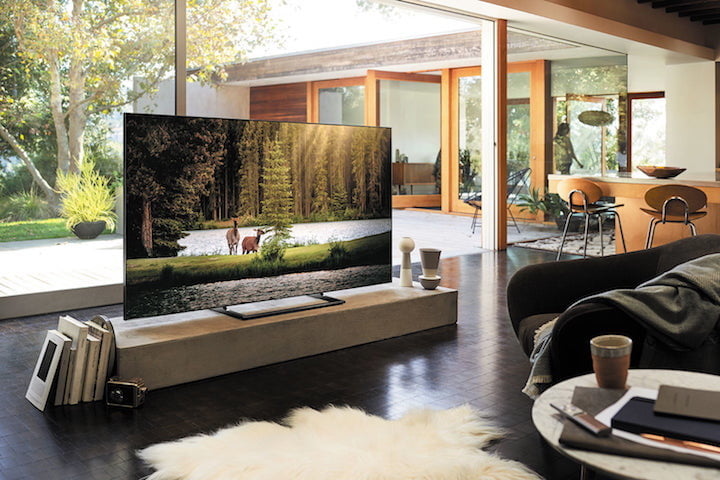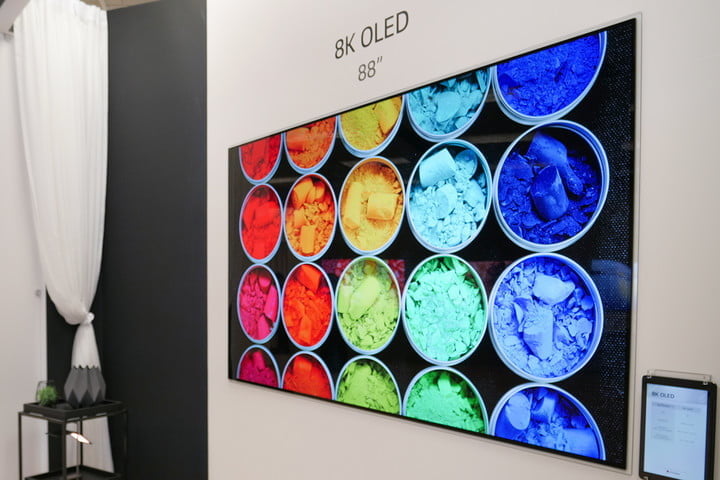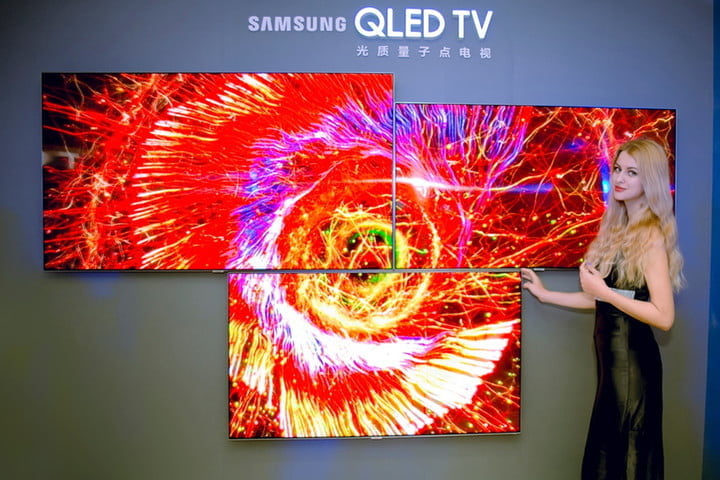If you are going to buy a new TV and you have begun to do the research on 4K existing in the market, it is very likely that you have already encountered two quite similar terms: QLED and OLED. What do they mean? What do these technologies really consist of?

OLED is somewhat similar to QLED in the sense that it is based on an LED screen, although the internal composition is somewhat different: QLED TVs work with the so-called quantum dots illuminated by a bright LED that is behind them, in circumstances that televisions OLEDs are composed of millions of individual light-emitting organic diodes. Both technologies deliver fantastic results, although the QLED stands out a little more.
We will analyze them a little more in detail, so that the next time you enter a store do not feel that the seller is speaking to you in an unknown language.
WHAT IS QLED?
QLEDs are LED televisions that use quantum dots to improve performance in key areas of image quality. Samsung, for example, says its own offer brightness levels that exceed any technology, while providing better black levels than other LED devices.
QLED refers to an LED TV that uses quantum dots to improve its performance.
How? The quantum dots act almost like a filter that produces a purer light than LED TVs can provide.

The purpose of their name is to differentiate them from simple LED TVs, and launch fully against OLEDs. Samsung has no plans to produce such devices, clearly. The company has its own answer in the form of microLED, a technology separate from its QLED TVs, and which you can find out in this note of CES 2018.
WHAT IS OLED?
This section is quite simple because there is not much technology behind an OLED TV. Let's start with the basics: OLED means organic light emitting diode. An OLED TV consists of millions of OLEDs, which take the form of individual pixels, and each lights individually when stimulated with electricity.
For this reason, when an individual OLED pxel does not receive power, it turns off and, therefore, appears completely black, as if the TV itself was turned off. In contrast, QLEDs cannot afford that, since they require a full LED backlight to feed the light through the film, and instead use software to dim the sections that should be black.
That's all you should know (in general terms, of course) about OLED TVs, in addition to the fact that while QLED TVs can be thin, OLEDs can be even more so. The reason for this is that they are not coated with the film that is applied to the QLED. It is also much easier to manufacture a flexible OLED display, which the pioneers of LG OLED have already done.
QLED vs. OLED
Let's start by examining how these two technologies compete in terms of contrast, viewing angle, brightness and other performance considerations.
BLACK LEVELS
The ability of a screen to produce deep and dark blacks is possibly the most important factor in achieving superior image quality. The deeper blacks allow for greater contrast and richer colors and, therefore, a more realistic and dazzling image. When it comes to black levels, OLED reigns as the undisputed champion.
 Rich Shibley / Digital Trends
Rich Shibley / Digital TrendsQLED TVs improve the black level performance of the LED display, but still depend on the backlights that glow behind an LCD panel. Even with advanced dimming technology which selectively tackles LEDs that do not need to be turned on at full capacity, QLED TVs still suffer from an effect called "light purge": the backlight is filtered in what is supposed to be a section black screen.
OLED TVs do not suffer from any of these problems. If an OLED pxel does not receive electricity, it produces no light and is therefore completely black. It seems an obvious choice for us.
Winner: OLED
Brightness
QLED TVs have a considerable advantage when it comes to the brightness capability. LED TVs were already good for becoming extremely bright, but the addition of quantum dots allows them to be even brighter. Because of this, QLED TVs claim a higher "color volume", which means they can make all colors in the available spectrum brighter without losing saturation. The manufacturers of QLED TVs also claim that they are better for HDR content because the spectral reflections in the images such as the brightness of the light that is reflected in a lake or a bright car, for example, are more powerful and more visible.

However, when it comes to the HDR argument, much can be said about the total contrast offered by the perfect black levels of an OLED TV. When you start from perfect black, the perceived contrast requires a less intense brightness in the areas highlighted for HDR programming, and the end result for the viewer is similar to that of a much brighter QLED TV, at least in a dark room. In rooms with a lot of ambient light, the brightness advantage of a QLED can be very useful to deliver that great visual impact that HDR content should offer.
Samsung's flagship models in 2018, the Q9 and Q8, added local full matrix attenuation, which only adds to the company's advantage in terms of maximum luminance. A new anti-reflective coating, along with other improvements in the panel, has also reduced the complaint of halo TVs or flourishing effect. Brightness without some of the disadvantages of LED? Excellent idea.
Winner: QLED
COLOR SPACE
OLED alone dominate this category, but the quantum dots, by improving the purity of the backlight, have allowed QLED TVs to increase the accuracy of color, brightness and color volume.
Samsung has implemented an expanded color volume in its 2018 QLED models, which could improve saturation at higher brightness levels, but we don't really have enough evidence to declare it a success.
Winner: tie
RESPONSE TIME
Response time refers to the time it takes for each individual diode to change from "on" to "off." With a faster response time, there is less movement and less artifacts (despite the source material).
OLED, with its smaller diodes that function as individual pixels, outperforms its opponent in response time. In contrast, the diodes on QLED TVs are not only slower, but they sit behind the LCD panel and illuminate groups of pixels, not individual ones. This causes a slower global change between the "on" and "off" states.
Winner: OLED
LAG INPUT
As for the delay in entry, LG has significantly improved its OLED TVs in this area, which makes them a real option for players who play competitive multiplayer titles, and Sony's do not stay behind (around 30 milliseconds ). We know that OLEDs are not a bad option for players, but it is still difficult to define which models will have less entry delay.
It is also difficult to classify OLED against its QLED competition because the entry delay on QLED TVs varies greatly from one model to another.
Winner: tie
VIEWING FROM NGULOS
OLED, again, is the winner here. With the QLED screens, the best viewing angle is in the dead center, and the image quality decreases both in color and in contrast the more one moves from side to side, or up and down. LG produces a type of LCD panel known as IPS that has a better down-angle performance than VA-type LCD panels, but it is still no competition for OLED technology.

OLED screens can be seen without luminance degradation at drastic viewing angles: up to 84 degrees. Some QLED TVs have improved in terms of viewing angle, but OLED still has a considerable advantage.
Winner: OLED
SIZE
OLED has come a long way in this category. When the technology was still incipient, the OLED screens reached a maximum of 55 inches. Today, an 88-inch OLED is available. That said, there are fewer limitations on LCD screen sizes, with QLEDs that reach up to 100 inches, and more. For most people, this is not a significant advantage, but technically speaking, QLED here wins.
Winner: QLED
LIFE EXPECTANCY
LG says you'll have to watch OLED TVs five hours a day for 54 years, before they fall to 50 percent in brightness. If that is true, this means that we still have not lost that brightness, since we remember that OLED TVs barely came out in 2013. For that reason, and only for that reason, we will grant this category to QLED, and They are the only ones who have a proven track record.
Winner (for now): QLED
Burned screen (or Burn-In)
To begin with, it is important that you know that the burnt screen is caused by the exposure of the television to static images for a prolonged period of time.
The effect that we have come to know as burned comes from the days of CRT square television, when prolonged viewing of a static image makes that image appear as "burned" on the screen.
What was really happening was that the matches covering the back of the TV screen shone for long periods of time without any rest, causing them to wear out and create the appearance of a burnt image.
QLED TVs are not susceptible to burnt screen
The same problem is at stake with OLED TVs, because the compounds that light up degrade over time. If you burn a pxel long and strong enough, cause it to hang prematurely and ahead of the rest of the pixels, creating a dark impression. However, in reality, this is not very likely to cause a problem for most viewers; since you will have to intentionally abuse TV to achieve this result.
Even the "error" (the graphic with the logo) used by certain channels disappears often enough to avoid causing burn problems. You will have to see ESPN all day, every day (for many days) in the brightest possible configuration to cause a problem, and even then it is not very likely.
That said, the potential is there, and must be taken into account. In particular, players who leave their television on while a static image remains on the screen, or who play for 10 hours a day for many weeks at a time, may cause some "burning" on an OLED television. However, it is worth noting that, QLED TVs are not susceptible to the burnt screen, and for that reason, they win the race in this line.
Winner: QLED
ENERGY CONSUMPTION
OLED panels are extremely thin, and do not require backlight. As such, OLED TVs are lighter and thinner than QLED TVs. They also require less energy, making them more efficient.
Winner: OLED
ACCESSIBILITY
As you probably have already found out, LG manufactures OLED TV panels, but other manufacturers take those panels and place them on their televisions. As a result, the different OLED TVs have very different operating systems and features, so we cannot comment on accessibility or use without going one by one.
However, we can ensure that Samsung has made its televisions, including, of course, the QLED family, quite easy to configure and use. While you have the application SmartThings From Samsung, the newest models will automatically obtain information from your smart phone, allowing them to download all your streaming applications and register with one touch (they will do the same with Wi-Fi).
That's not all: Samsung's uninterrupted mounting system and the Invisible box One connect They make mounting a QLED and hiding the cables surprisingly simple. The operating system Tizen Samsung is also easy and easy to manage.
Winner: QLED
PRICE
Before, this category would have been easily won by the QLEDs, but OLED TVs have dropped in price, and since we are talking about high quality, comparable QLED TVs cost more or less the same. Between OLED and QLED, the price category is simply not a consideration in this dispute.
Winner: Draw
Definitely
When comparing QLED with OLED in terms of image quality, OLED is at the forefront, despite the fact that QLED is a newer technology, which represents a significant advance over the LED TVs of yesteryear. OLED technology is lighter, thinner, consumes less energy, offers the best viewing angle and, although still a bit more expensive, has dropped considerably in price.
QLED has its own set of advantages, especially with its brightness capability and black level settings. For many, a QLED TV will deliver a better image during the day, with more ntids colors. But when the lights go out, OLED is an unsurpassed option.
* Article updated on July 5 de 2019 by Daniel Matus.
Editor Recommendations
